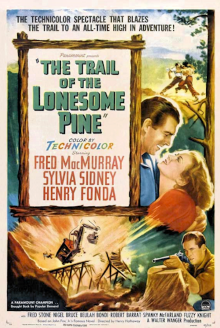
With this selection, the course’s list leaves the black and white era behind and enters the world of color movies. In truth, while The Trail of the Lonesome Pine was indeed one of the earliest Hollywood movies to be filmed in color, Hollywood continued to regularly produce black and white movies well into the 1960s at least. There are many reasons for this and not all of them are stylistic. Cost is always a consideration and there were worries about technological limitations and whether or not particular directors and their crew were comfortable and experienced with working in color.
This film then is doubly innovative, not only by being a major production that is filmed entirely in color, but also by doing it outdoors. It is marketed as a romance but that description is deceptive since its scope is much broader than that. Set amidst the hills of rural Kentucky but actually shot in California, it uses color to great effect to impress you with vistas of cloud-capped peaks and hills of verdant pines. One can only imagine what a breathtaking sight this must have seemed to audiences used only to black and white movies. It’s worth noting that its source material, a novel published in 1908, has been adapted for film many times before but this seems to be the definitive version because they stopped making new ones after this.
It tells the story of two feuding clans, the Tollivers and the Falins, who have been fighting and killing each other for generations. But the modern world catches up with them when an engineer, Jack Hale, approaches both families and offers them a large amount of money to develop a coal mine nearby and build a railway line across their land. Naturally, the Tollivers’ beautiful but uneducated daughter, June, falls for the sophisticated and smart outsider. But development brings change and change causes resentment when it means abandoning a long established lifestyle and its prejudices.
The central romance between Jack and June is entertaining enough even if it follows a predictable arc. I found the jokes that exploit June’s provincialism and lack of book learning to be funny, if a little off color. But I really appreciated how the romance is only one part of the larger theme that modernity is essentially good. This includes economic and industrial development, scientific and cultural knowledge, material wealth and in a certain sense, even female emancipation. The character of the young Buddie Tolliver, who discovers in himself a love of engineering machines and books, exemplifies this theme.
At the same time, the film doesn’t skip over how wonderful nature is either. The cinematography and color evokes the setting so vividly that you can practically smell the scent of pine in the air. The wandering Tater and his songs of the woods are meant to charm you. It doesn’t elaborate of course on how to strike a proper balance between development that cuts down trees and conservation that preserves all this rustic beauty, but it is refreshing to watch a Hollywood film in which bulldozers and excavators are an unironic force for good.
But that’s not the only way in which the film breaks with modern Hollywood sensibilities. It’s a huge spoiler to say it but I was really shocked that the film allows Buddy to die. I guess I’m just too used to how modern Hollywood never kills kids, no matter the degree of danger they are put in. In The Trail of the Lonesome Pine, this dramatically powerful event sets up the film for the climax and you’re reminded that the feud between the families is deadly business. For underneath all the sunshine and pleasant scenery, the charming songs and goofy jokes, there’s a viciousness in these small-minded, isolated communities.
I guess my biases are showing here but all of these reasons, I enjoyed this film the most of all of the selections chosen for this course. I also think given how different its politics are, modern audiences would find it interesting and refreshing to watch, even if they didn’t care for its place in the history of Hollywood.